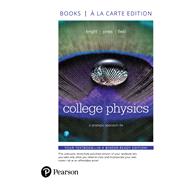This loose-leaf, three-hole punched version of the textbook gives students the flexibility to take only what they need to class and add their own notes–all at an affordable price.
For courses in algebra-based introductory physics.
Make physics relevant for today's mixed-majors students
College Physics: A Strategic Approach, 4th Edition expands its focus from how mixed majors students learn physics to focusing on why these students learn physics. The authors apply the best results from educational research and Mastering™ Physics metadata to present basic physics in real world examples that engage students and connect physics with other fields, including biological sciences, architecture, and natural resources. From these connections, students not only learn in research-driven ways but also understand why they are taking the course and how it applies to other areas.
Extensive new media and an interactive Pearson eText pique student interest while challenging misconceptions and fostering critical thinking. New examples, explanations, and problems use real data from research to show physics at work in relatable situations, and help students see that physics is the science underlying everything around them. A Strategic Approach, 4th Edition, encourages today’s students to understand the big picture, gain crucial problem-solving skills and come to class both prepared and confident.
Also available with Mastering Physics
Mastering™ is the teaching and learning platform that empowers you to reach every student. By combining trusted author content with digital tools developed to engage students and emulate the office-hour experience, Mastering personalizes learning and often improves results for each student. With Learning Catalytics™ instructors can expand on key concepts and encourage student engagement during lecture through questions answered individually or in pairs and groups. Students also master concepts through book-specific Mastering Physics assignments, which provide hints and answer-specific feedback that build problem-solving skills. Mastering Physics now provides students with the new Physics Primer for remediation of math skills needed in the college physics course.
NOTE: You are purchasing a standalone product; Mastering™ Geography does not come packaged with this content. Students, if interested in purchasing this title with Mastering Geography, ask your instructor to confirm the correct package ISBN and Course ID. Instructors, contact your Pearson representative for more information.
If you would like to purchase both the loose-leaf version of the text and Mastering Geography, search for:
- 013464414X / 9780134644141 College Physics: A Strategic Approach , Books a la Carte Plus MasteringPhysics with Pearson eText -- Access Card Package, 4/e








